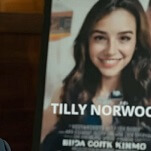Becoming Unbecoming (Arsenal Pulp Press) is not an easy read, but it is an essential one. This graphic memoir by Una took seven years to create, and its pages are overflowing with raw emotion, channeling the cartoonist’s immense pain and frustration over the misogyny and violence women face on a regular basis. Beginning as an account of the sexual trauma Una experienced as a teen growing up in Yorkshire in the ’70s, the book connects Una’s tragedy with the fate of the women killed by the Yorkshire Ripper serial killer during her adolescence, and then builds off both of those threads to explore larger ideas concerning the mistreatment of women throughout history.
Becoming Unbecoming feels especially timely at the tail-end of a U.S. election year where misogyny has run rampant, but one of the saddest things about this book is that it will likely always be timely unless there are major cultural changes worldwide regarding men’s attitudes toward women. Una’s personal trauma is harrowing on its own, but she also knows she’s just one of the millions of women who have been victimized by men, whether it’s physically or emotionally, in person or online. She delves into why men are allowed dominance over women in society and how this diminishes the self-worth of women and their comfort with sexual expression, and the personal focus at the start of the memoir makes it easy to engage with the macro concepts that make up much of the back half.
The looseness of Una’s artwork gives the storytelling a strong sense of spontaneity and immediacy, and while there’s clearly a lot of craft behind the visuals, particularly in the page compositions, the art style gives the impression that Una is rapidly putting these images on the page to make the narrative a more visceral reflection of her memories. For the most part, Una doesn’t fuss over the details too heavily, so when she does, the moments hit with extra impact. When Una writes about her physical changes in adolescence, she provides intricate pencil illustrations of an insectoid woman to highlight how alien her new body feels. Her head shots of three Congolese women trying to help sexual assault victims in their country (once branded the rape capital of the world) are rendered with precision that reinforces their personhood and makes them stand out amongst the simpler representations of other figures in the book.
The image of Una holding an empty word balloon reappears throughout Becoming Unbecoming. Sometimes the balloon carries her into the air, representing the freeing sensation of speaking out about her trauma and the trauma of other women. Sometimes she carries the balloon like a heavy weight, which can be interpreted as the burden of silence or the difficulty of raising your voice when history has shown that women who do speak out often suffer worse consequences than the men who hurt them. Una has complicated feelings about sharing her story, but in the end she knows that silence won’t change anything, and hopefully her story will help women who have suffered similar experiences while instilling a greater sense of empathy in male readers. [Oliver Sava]
Told through a trio of interlocking stories, Luke Healy’s
How To Survive In The North (Nobrow Press) explores the Arctic voyages of explorer Vilhjalmur Stefansson, using them as a canvass to paint pictures more broadly concerning loneliness, marginalization, and self-alienation. Stefansson went on two expeditions, one in 1913 and another in 1921, and it is these stories that Healy tells. But he also adds in the contemporary story of a gay college professor who, discovering Stefansson once worked in his office, begins reading about these two voyages and Stefansson more generally.
Beginning at the end of this triptych, How To Survive In The North opens with its three central characters—1913’s Robert Bartlett, 1921’s Ada Blackjack, 2013’s Sully Barnaby—at their lowest point: facing death, intense isolation, and crippling emotional devastation. Healy cuts from one to other, evincing their despair, before an explosion of color ripples across the sky: the Aurora Borealis. The banners of effervescent color wave against a black sky dotted with white stars, representing the triune narrative that composes the book. They also make up the striking color palette that pervades and defines the book, which is dominated by yellow, orange wood, pink skies, and aquamarine water. Foregrounded against these backdrops rest clean figures, made of thin, wispy, sometimes-non-intersecting lines, both striking and immediate in their simplicity. With a sumptuous mix of clarity and density, these figures express themselves in minute ways, little lines, and small gestures—a shift in posture, a turn of the head, a shift in the lines that compose the eyes, the mouth. How To Survive In The North is a deeply felt work about grappling with the consequences of your own poor decisions, and it is in these minor details that Healy explicates that thoughtful observation of intimate human drama.
When faced with their decisions, each of the protagonists choose poorly, and it is here that Healy finds the engine of drama that propels his work. Robert Bartlett, captain of Stefansson’s ill-fated 1913 expedition, embarks on the journey knowing he lacks the proper crew and the proper vessel; Ada Blackjack, an Inuit seamstress who accepts a position on the 1921 journey’s crew, goes too far north knowing that she may die; Sully, a professor studying Stefansson, indulges in his attraction to a pupil. In the case of Bartlett and Blackjack, circumstance forces them into their choice—they know the mistake they are making, but it’s do it or die. In these two fact-based stories, Healy isolates his protagonists narratively, but also visually. He shunts them to the edges of panels and the backgrounds of compositions, literally marginalizing them. In Sully’s story, however, he doesn’t face a Hobson’s choice; Sully’s choices arise from selfishness rather than self-preservation. Healy renders Bartlett and Blackjack as having been withdrawn from the world but Sully as having been abandoned by it. This visual tension draws How To Survive In The North taught with a knotted dread, and it makes the tragedy weighting and affecting.
It is most unfortunate, however, that the climax sees the book’s themes made textual, Healy putting them into the mouth of Sully. It doesn’t totally deflate the ballooning drama, but it does noticeably blemish an otherwise accomplished comic. [Shea Hennum]
As the line between comics and TV continues to blur, it’s inevitable to find a book that feels like a test pilot.
Briggs Land #3 (Dark Horse) comes across like the perfect conclusion to a gripping first episode. It could even drop directly into a show like
Longmire, fully formed and ready to go.
Briggs Land is the story of a geographically isolated “family” of hundreds who straddle the line of actually seceding, declaring themselves sovereign citizens and generally refusing to recognize any government besides their own. With the imprisonment of patriarch Jim Briggs, leadership has fallen to his wife Grace, who finds herself struggling against both internal and external forces that want to tear her way of life apart.
It’s not hard to sympathize with Grace, though it feels a little strange. She’s facing down a group of men who do not think a woman can possibly lead them, including two of her own sons, and attempting to deal with more than one person wanting her dead, not to mention the feds following her around. But she’s become the head of a family that is founded on organized crime and a clear belief that they are better than the rest of the world. Writer Brian Wood doesn’t have the best history with women, fictional or factual, but Grace is a nuanced character who’s flawed and formidable at the same time. Grace is still bent on keeping Briggs land separate from the world and her family intact, but she very quickly rejects many of the laws and beliefs that Jim had been imposing on the group for years. It’s a very visceral and visible reclamation of female power and empathy that’s fascinating to read.
Lee Loughridge’s colors are, as always, incredible. He paints upstate New York in flat grays and warm yellows that show temperature and tone and cast Briggs land in a particular and very telling kind of light. Artist Mack Chater, a relative newcomer, does a great job with backgrounds and action in particular, creating a sense of space and scale that’s invaluable when dealing with a story that’s so deeply rooted in physical isolation and the effort it takes to get there. He’s got a good handle on body language and male faces, but there’s something lacking when it comes to the women. He’s certainly not the only artist to struggle with this problem, but while his men are easily distinguished from one another, features rich with lines, the women are all smooth and soft. If it weren’t for their hair and clothing they would be difficult to tell apart, which is unfortunate in a comic so specifically focused on women.
With the end of this first story arc, Briggs Land #3 proves there’s a lot of material yet to be mined in familiar stories: Imagine Lord Of The Flies with all young women, The Walking Dead with mostly people of color, Breaking Bad if Skyler was the one who knocks. Taking a popular trope and turning it just enough to see it from a completely different perspective makes for good storytelling, in this instance. [Caitlin Rosberg]
Cyberpunk is well-trod territory in 2016. Given that we appear at times to live in an actual dystopian future where humanity is oppressed by corporate controlled computer technology, reading about a fictional dystopian future where humanity is oppressed by corporate controlled computer technology has taken a tumble down the list of attractive leisure activities. Given this, Wren McDonald had a tall bar to clear with
Sp4rx (Nobrow). While on first glance merely another cyberpunk pastiche, the book announces its arrival with a surprising degree of wit and style.
Sometimes all that’s necessary to make the old songs shine is to sing them in a new way. Sp4rx somehow manages to be both a fairly standard—downright predictable—cyberpunk thriller, and a showcase for McDonald’s stylistically engaging and endlessly inventive cartooning. He’s got a bit of Moebius and a bit of Hergé, but his clearest contemporary forerunner is Jason: McDonald’s work doesn’t concern anthropomorphic animals, but it is similarly built around creating deceptively immersive environments with a deadpan simplicity that masks a great deal of skill. Although his figures appear cartoony and weightless in isolation, on the page they exist in the context of a detailed world made to the same specifications. It works, inasmuch as every panel and page reveal small peculiarities of the not-so-strange future world in which our heroes operate. Walls have dents and stray cats are always poking in where they don’t belong.
The plot of Sp4rx is so boilerplate as to seem intentional parody. A young hacker named Sp4rx is drafted into a resistance movement dedicated to fighting the evil megacorporation Structus Industries. Structus is trying to implant every worker in the lower levels of Avalon with computer technology supposedly intended to aid in productivity but actually designed to overwrite independence. All fairly standard stuff, and anyone looking for a twist on these tropes should probably look elsewhere. Where the book succeeds is in never once losing its cool or swerving from its very precise aesthetic. It’s surprisingly elastic: not simply adept at drawing ratty future slums and decaying high tech, McDonald uses sudden acts of violence as a means of retaining the reader’s attention. There’s quite a bit of complicated staging at work throughout the book, using the kind of sophisticated blocking and panel composition that is very rare to see in a debut graphic novel.
What the book lacks in novelty it makes up for in execution and relevancy. Although McDonald is clever not to hang his story on current events, he peppers the book with various thematic bits that update a few of the old shopworn cyberpunk clichés for the contemporary moment. Police exist only to exercise draconian measures to protect private property and quell rioting. The computerized zombies who sweep the levels looking for resistance asks of everyone they encounter, “How do you contribute to the efficiency of this level?” Independence is happily sacrificed for convenience and security in the context of a system made precarious for the sole purpose of forcing people to sacrifice their independence. Sound familiar? [Tim O’Neil]







































